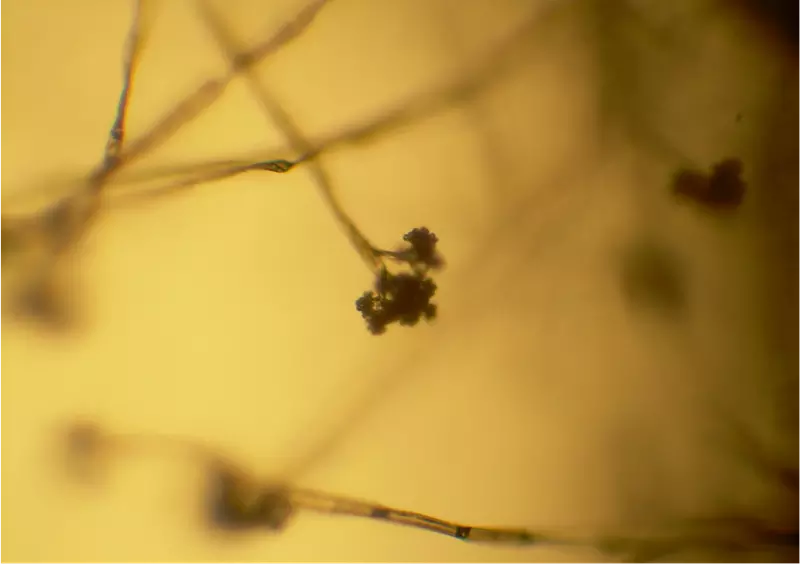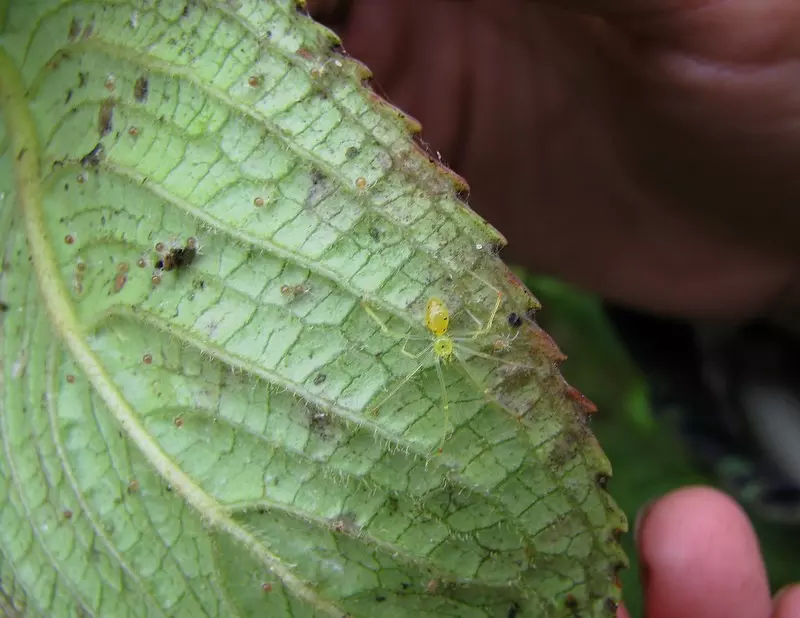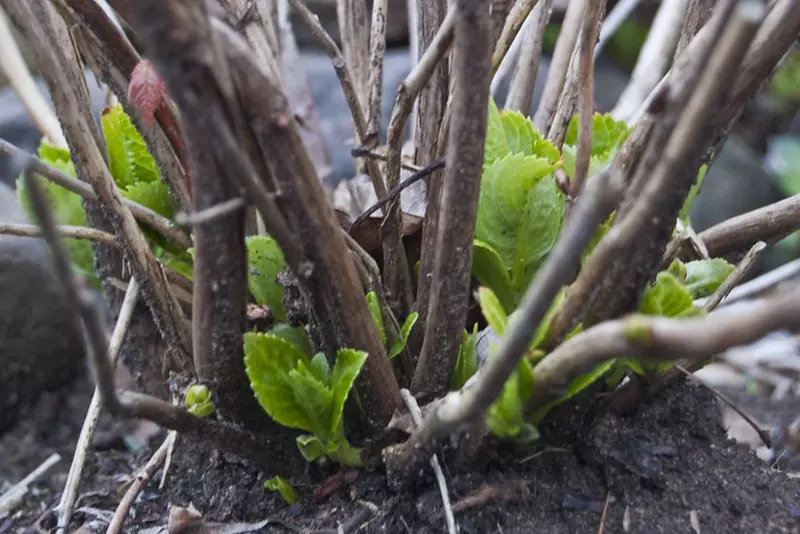Table of Contents
Hydrangeas are loved for their stunning blooms and vibrant foliage, but they can be vulnerable to various diseases. Understanding the symptoms and knowing how to treat these problems effectively can help keep your hydrangeas healthy and flourishing.
 Botrytis Blight (Grey Mould) - By I, By Ninjatacoshell - Own work, CC BY-SA 3.0, Link
Botrytis Blight (Grey Mould) - By I, By Ninjatacoshell - Own work, CC BY-SA 3.0, Link
Understanding and Managing Leaf Spot Diseases in Hydrangeas
Hydrangeas are cherished for their lush foliage and vibrant blooms. However, they are susceptible to various leaf spot diseases that can mar their beauty and affect overall plant health. This article delves into the causes, symptoms, and management strategies for leaf spot diseases in hydrangeas.
What Are Leaf Spot Diseases?
Leaf spot diseases are conditions characterised by the appearance of spots on plant leaves, often caused by fungal or bacterial pathogens. In hydrangeas, these spots can vary in size, colour, and pattern, potentially leading to reduced vigour and aesthetic appeal.
Common Causes of Leaf Spot in Hydrangeas
Several pathogens are known to cause leaf spot diseases in hydrangeas:
- Fungal Pathogens: Species such as Cercospora, Alternaria, and Phyllosticta are common culprits. These fungi thrive in moist conditions and can spread rapidly, especially during periods of heavy rainfall or high humidity.
- Bacterial Pathogens: The bacterium Xanthomonas can cause bacterial leaf spot, particularly in oakleaf hydrangeas. Moist environments facilitate the spread of this bacterium, leading to angular, reddish-purple spots on the foliage.
Identifying Symptoms
Recognising the symptoms of leaf spot diseases is crucial for early intervention:
- Initial Spots: Small, circular spots that may be brown, purple, or black, typically appearing on the lower leaves first.
- Progression: Spots may enlarge, merge, and develop grey or tan centres with dark borders. In severe cases, leaves may turn yellow and drop prematurely.
- Bacterial Infections: Angular spots with water-soaked appearances, often leading to leaf curling or distortion.
Environmental Factors Contributing to Leaf Spot
Certain environmental conditions can exacerbate leaf spot diseases:
- Moisture: Prolonged leaf wetness from overhead watering or frequent rain creates an ideal environment for pathogen proliferation.
- Air Circulation: Dense planting and poor airflow can trap moisture around foliage, promoting disease development.
- Temperature: Warm, humid conditions are particularly conducive to the spread of fungal leaf spot pathogens.
Management and Treatment Strategies
Effective management of leaf spot diseases involves a combination of cultural practices and, when necessary, chemical treatments:
Cultural Practices
- Watering Techniques: Employ drip irrigation or water at the base of the plant to keep foliage dry. Watering early in the day allows any moisture on leaves to evaporate quickly.
- Pruning: Remove and dispose of infected leaves to reduce pathogen load. Ensure tools are sterilised between cuts to prevent disease spread.
- Plant Spacing: Space plants appropriately to enhance air circulation, reducing the humidity around foliage.
- Sanitation: Clear fallen leaves and debris from around plants to eliminate sources of infection.
Chemical Treatments
- Fungicides: Apply fungicides labelled for leaf spot control, such as those containing chlorothalonil or mancozeb, following manufacturer instructions. Initiate treatments at the first sign of disease and repeat as recommended.
- Bactericides: For bacterial leaf spots, copper-based bactericides can be effective. However, they may not cure existing infections but can help prevent further spread.
Preventive Measures
Preventing leaf spot diseases is more effective and sustainable than treating them after they occur:
- Resistant Varieties: Select hydrangea cultivars known for disease resistance.
- Proper Planting Sites: Choose locations with good air circulation and well-drained soil to reduce moisture levels around plants.
- Regular Monitoring: Inspect plants frequently for early signs of disease, allowing for prompt intervention.
- Seasonal Clean-Up: In autumn, remove and destroy fallen leaves to minimise overwintering of pathogens.
Leaf spot diseases can significantly impact the health and appearance of hydrangeas. By understanding the causes, recognising symptoms early, and implementing effective cultural and chemical management strategies, gardeners can maintain the vitality and beauty of their hydrangea plants.
Further Reading
For more detailed information on leaf spot diseases and their management, consider consulting the following resources:
Managing Powdery Mildew on Hydrangeas
Hydrangeas are renowned for their vibrant blooms and lush foliage. However, they can be susceptible to powdery mildew, a common fungal disease that affects many ornamental plants. This article provides an in-depth look at powdery mildew on hydrangeas, including its causes, symptoms, and effective management strategies.
What Is Powdery Mildew?
Powdery mildew is a fungal disease characterised by white or grey powdery growth on the surfaces of leaves, stems, and sometimes flowers. Unlike many fungal pathogens, powdery mildew thrives in warm, dry conditions with high humidity, making it a prevalent issue in various climates.
Causes of Powdery Mildew on Hydrangeas
In hydrangeas, powdery mildew is primarily caused by the fungus Golovinomyces orontii. This pathogen spreads through airborne spores that land on plant surfaces, germinate, and infect the host tissue. Factors contributing to its development include:
- High Humidity: Elevated humidity levels promote spore germination and fungal growth.
- Poor Air Circulation: Dense planting or inadequate pruning can reduce airflow, creating a favourable environment for the fungus.
- Shaded Conditions: Excessive shade can increase susceptibility to powdery mildew.
Identifying Symptoms
Early detection of powdery mildew is crucial for effective management. Symptoms include:
- White Powdery Spots: Initial signs appear as small, white, powdery spots on the upper leaf surfaces.
- Expansion: Spots enlarge and spread to cover larger areas, including stems and buds.
- Leaf Discolouration: Leaves may develop red or purple blotches alongside the powdery growth.
- Leaf Deformation: Severe infections cause leaves to curl, pucker, or become stunted.
- Premature Leaf Drop: Infected leaves may yellow and drop prematurely, weakening the plant.
Management and Treatment Strategies
Managing powdery mildew effectively requires a combination of cultural practices and chemical interventions.
Cultural Practices
- Improve Air Circulation: Prune hydrangeas to remove overcrowded branches and increase airflow around the foliage.
- Proper Spacing: Plant hydrangeas with enough space between them to reduce humidity levels and promote air movement.
- Watering Techniques: Water the base of the plant to avoid wetting leaves, reducing the humidity that encourages fungal growth.
- Choose Planting Sites Wisely: Select locations with morning sun to help dry dew on leaves quickly.
Chemical Treatments
- Fungicides: Use fungicides containing sulphur, neem oil, or potassium bicarbonate. Apply these at the first sign of infection and repeat as recommended by the manufacturer.
- Organic Remedies: A baking soda solution (1 tablespoon baking soda mixed with 1 litre of water and a few drops of liquid soap) can be used as a preventative spray.
Preventive Measures
Preventing powdery mildew is more effective than treating it after infection. Consider the following:
- Resistant Varieties: Choose hydrangea cultivars known for resistance to powdery mildew.
- Monitor Regularly: Inspect plants frequently, especially in high-humidity periods, to catch early signs of disease.
- Cleanliness: Remove and dispose of fallen leaves and debris to prevent fungal spores from overwintering and spreading.
Powdery mildew can detract from the beauty and health of hydrangeas, but with proper care, it can be effectively managed. By understanding the conditions that favour this disease and implementing preventive measures, you can maintain healthy, vibrant hydrangeas in your garden.
Further Reading
For more detailed information on powdery mildew and its management, explore these trusted resources:
Botrytis Blight (Grey Mould) on Hydrangeas
Hydrangeas are cherished for their lush blooms and vibrant foliage. However, they are susceptible to various diseases, including Botrytis blight, commonly known as grey mould. This article delves into the specifics of Botrytis blight on hydrangeas, exploring its causes, symptoms, and effective management strategies.
What Is Botrytis Blight?
Botrytis blight is a fungal disease caused by Botrytis cinerea. It manifests as greyish-brown mould on plant tissues, particularly affecting flowers, leaves, and stems. The fungus thrives in cool, damp conditions, making hydrangeas particularly vulnerable during wet seasons.
Causes of Botrytis Blight in Hydrangeas
The development of Botrytis blight is influenced by several environmental factors:
- High Humidity and Moisture: Prolonged wet conditions create an ideal environment for fungal growth.
- Poor Air Circulation: Dense foliage and overcrowded plantings hinder airflow, promoting moisture retention.
- Cool Temperatures: The fungus is most active in cool, damp weather, typically in spring and autumn.
- Plant Debris: Dead or decaying plant material can harbour fungal spores, facilitating infection.
Identifying Symptoms of Botrytis Blight
Early detection of Botrytis blight is crucial for effective management. Key symptoms include:
- Flower Discolouration: Petals develop water-soaked spots that progress to reddish-brown lesions, often leading to premature browning and wilting.
- Leaf Spots: Infected leaves exhibit brown or grey spots, which may enlarge and cause leaf drop.
- Stem Lesions: Stems may develop dark, sunken areas, potentially leading to dieback.
- Grey Mould: A fuzzy, greyish mould appears on affected tissues, especially under humid conditions.
Management and Treatment Strategies
Controlling Botrytis blight involves a combination of cultural practices and, when necessary, chemical treatments.
Cultural Practices
- Pruning: Remove and dispose of infected plant parts promptly to reduce the spread of spores. Ensure tools are sterilised between cuts to prevent cross-contamination.
- Improving Air Circulation: Space plants appropriately and thin dense growth to enhance airflow, reducing humidity around foliage.
- Watering Techniques: Water at the base of the plant to keep foliage dry. Avoid overhead watering, especially during late afternoon or evening.
- Sanitation: Clear fallen leaves and debris from around plants to eliminate potential sources of infection.
Chemical Treatments
In cases of severe infection, fungicidal applications may be necessary:
- Fungicides: Apply fungicides labelled for Botrytis control, such as those containing chlorothalonil or thiophanate-methyl. Follow manufacturer instructions regarding application rates and timing.
- Preventive Applications: In environments prone to Botrytis blight, consider preventive fungicide treatments during periods of high risk, particularly in cool, damp weather.
Preventive Measures
Preventing Botrytis blight is more effective than treating established infections. Implement the following strategies:
- Plant Selection: Choose hydrangea varieties less susceptible to fungal diseases.
- Environmental Control: Manage garden conditions to reduce humidity, such as ensuring proper spacing and avoiding overhead irrigation.
- Regular Monitoring: Inspect plants frequently, especially during favourable conditions for fungal growth, to detect and address early signs of disease.
Botrytis blight poses a significant threat to the health and aesthetics of hydrangeas. By understanding its causes and symptoms, and by implementing effective cultural and chemical management strategies, gardeners can mitigate the impact of this disease and maintain the vitality of their hydrangea plants.
Further Reading
For more detailed information on Botrytis blight and its management, consider consulting the following resources:
Rust
Hydrangeas are beloved for their vibrant blooms and lush foliage. However, they can be susceptible to various diseases, including rust—a fungal infection that manifests as discoloured spots on the leaves. This article delves into the specifics of rust on hydrangeas, exploring its causes, symptoms, and effective management strategies.
What Is Rust?
Rust is a fungal disease caused by pathogens in the genus Pucciniastrum, specifically Pucciniastrum hydrangeae in hydrangeas. It presents as orange, yellow, or brown pustules on the undersides of leaves, often corresponding with yellow spots on the upper surfaces. While rust rarely kills hydrangeas, it can weaken them, affecting their overall vigour and aesthetic appeal.
Causes of Rust in Hydrangeas
The development of rust in hydrangeas is influenced by several factors:
- High Humidity and Moisture: Rust fungi thrive in moist environments, making overwatered gardens or areas with poor drainage susceptible.
- Poor Air Circulation: Dense planting or lack of pruning can reduce airflow, creating a humid microclimate favourable to fungal growth.
- Alternate Hosts: Some rust fungi require alternate hosts to complete their life cycle. For instance, Pucciniastrum hydrangeae alternates between hydrangeas and hemlock trees.
Identifying Symptoms of Rust
Recognising rust early can prevent severe infestations. Key symptoms include:
- Orange to Brown Pustules: Small, raised pustules on the undersides of leaves.
- Yellow Spots: Corresponding yellow or pale spots on the upper leaf surfaces.
- Premature Leaf Drop: Infected leaves may wither and fall off prematurely.
- Reduced Vigour: Severe infections can lead to stunted growth and diminished flowering.
Management and Treatment Strategies
Effective management of rust involves cultural practices and, in severe cases, chemical treatments.
Cultural Practices
- Pruning: Remove and dispose of infected leaves promptly to reduce spore spread. Ensure pruning tools are sterilised between cuts to prevent cross-contamination.
- Improving Air Circulation: Space plants appropriately and thin dense growth to enhance airflow, reducing humidity around foliage.
- Watering Techniques: Water at the base of the plant to keep foliage dry. Avoid overhead watering, especially during late afternoon or evening.
- Sanitation: Clear fallen leaves and debris from around plants to eliminate potential sources of infection.
Chemical Treatments
In cases of severe infection, fungicidal applications may be necessary:
- Fungicides: Apply fungicides labelled for rust control, such as those containing sulphur or copper-based compounds. Follow manufacturer instructions regarding application rates and timing.
- Preventive Applications: In environments prone to rust, consider preventive fungicide treatments during periods of high risk, particularly in humid conditions.
Preventive Measures
Preventing rust is more effective than treating established infections. Implement the following strategies:
- Plant Selection: Choose hydrangea varieties less susceptible to fungal diseases.
- Environmental Control: Manage garden conditions to reduce humidity, such as ensuring proper spacing and avoiding overhead irrigation.
- Regular Monitoring: Inspect plants frequently, especially during favourable conditions for fungal growth, to detect and address early signs of disease.
Rust can compromise the health and beauty of hydrangeas. By understanding its causes and symptoms, and by implementing effective cultural and chemical management strategies, gardeners can mitigate the impact of this disease and maintain the vitality of their hydrangea plants.
Further Reading
For more detailed information on rust and its management, consider consulting the following resources:
Hydrangea Ringspot Virus
Hydrangeas are cherished for their vibrant blooms and lush foliage. However, they are susceptible to various diseases, including the Hydrangea Ringspot Virus (HRSV). This article delves into the specifics of HRSV, exploring its causes, symptoms, and effective management strategies.
What Is Hydrangea Ringspot Virus?
Hydrangea Ringspot Virus (HRSV) is a plant pathogenic virus belonging to the family Alphaflexiviridae. It primarily affects Hydrangea macrophylla, leading to distinctive ring-shaped spots on the leaves, which can compromise the plant's aesthetic appeal and overall health.
Causes and Transmission
HRSV is transmitted through mechanical means, particularly via contaminated tools during pruning or propagation. The virus can also spread through infected sap, making it crucial to maintain proper hygiene when handling hydrangeas. Notably, HRSV is not transmitted by aphids or other insect vectors.
Identifying Symptoms
Recognising HRSV early is vital for effective management. Key symptoms include:
- Ring-Shaped Spots: Yellow or brown circular spots on the leaves, often with a chlorotic (yellow) halo.
- Leaf Distortion: Affected leaves may become distorted, curled, or exhibit rolling.
- Stunted Growth: Infected plants may experience reduced growth and diminished vigour.
- Flower Deformities: In some cases, flowers may display irregular streaks of colour or reduced blooming.
Management and Treatment Strategies
Currently, there is no cure for HRSV. Management focuses on prevention and mitigating the spread of the virus.
Preventive Measures
- Sanitise Tools: Regularly disinfect pruning shears and other gardening tools with a solution of bleach or alcohol to prevent mechanical transmission.
- Use Virus-Free Stock: Ensure that new plants or cuttings are sourced from reputable suppliers who provide virus-indexed (certified virus-free) specimens.
- Avoid Overhead Watering: Water at the base of the plant to minimise leaf wetness, reducing the risk of viral spread through sap.
- Monitor and Remove Infected Plants: Regularly inspect hydrangeas for symptoms of HRSV. If infection is confirmed, remove and properly dispose of the affected plant material to prevent further spread.
Hydrangea Ringspot Virus poses a significant challenge to maintaining the health and beauty of hydrangeas. While there is no direct treatment, implementing stringent preventive measures and practising good garden hygiene can help manage and reduce the impact of this virus, ensuring that your hydrangeas continue to thrive.
Further Reading
For more detailed information on Hydrangea Ringspot Virus and its management, consider consulting the following resources:
Understanding and Managing Stem and Bulb Nematode in Hydrangeas
Hydrangeas are cherished for their vibrant blooms and lush foliage. However, they can fall victim to various pests, including the stem and bulb nematode (Ditylenchus dipsaci), a microscopic worm that infiltrates plant tissues, leading to significant damage. This article delves into the specifics of stem and bulb nematodes in hydrangeas, exploring their causes, symptoms, and effective management strategies.
What Are Stem and Bulb Nematodes?
Stem and bulb nematodes are microscopic, unsegmented roundworms that parasitise a wide range of plants, including hydrangeas. They feed within soft plant tissues, such as stems and leaves, causing cell death and distorted growth. These nematodes thrive in cool, moist conditions and can persist in plant debris, soil, and even on gardening tools, making them challenging to eradicate.
Causes and Transmission
The primary factors contributing to stem and bulb nematode infestations in hydrangeas include:
- Contaminated Plant Material: Introducing infected plants or bulbs into the garden can spread nematodes.
- Soil and Water Movement: Nematodes can move through soil moisture, facilitating their spread to healthy plants.
- Infected Tools: Using unsterilised gardening tools can transfer nematodes from infected to healthy plants.
Identifying Symptoms
Early detection of stem and bulb nematode infestation is crucial. Key symptoms in hydrangeas include:
- Stunted Growth: Affected plants exhibit reduced growth and may appear dwarfed.
- Leaf Distortion: Leaves become twisted, thickened, or distorted.
- Stem Swelling: Infected stems may swell or develop galls.
- Wilting and Yellowing: Leaves may turn yellow and wilt, especially during warm periods.
- Necrotic Tissue: Dead, brown areas may develop on stems and leaves.
Management and Treatment Strategies
Controlling stem and bulb nematodes involves a combination of cultural practices and, in severe cases, chemical treatments.
Cultural Practices
- Sanitation: Remove and destroy infected plant material promptly to reduce nematode populations. Avoid composting infected debris.
- Crop Rotation: Rotate with non-host plants to reduce nematode levels in the soil. Suitable rotation crops include carrots, potatoes, spinach, corn, and wheat, as they are poor hosts for stem and bulb nematode. :contentReference[oaicite:0]{index=0}
- Soil Solarisation: Cover moist soil with clear plastic during hot weather to heat the soil and kill nematodes.
- Tool Sterilisation: Disinfect gardening tools with a solution of bleach or alcohol after working with infected plants to prevent the spread of nematodes.
Chemical Treatments
Currently, there are limited chemical options available for home gardeners to control stem and bulb nematodes. Emphasis should be placed on cultural practices and preventive measures.
Preventive Measures
Preventing nematode infestations is more effective than treating established problems. Implement the following strategies:
- Purchase Healthy Plants: Acquire hydrangeas from reputable nurseries that ensure plants are free from nematodes.
- Inspect New Plants: Examine new plants for signs of nematode damage before introducing them to your garden.
- Maintain Garden Hygiene: Keep the garden free from plant debris and weeds that may harbour nematodes.
- Use Nematode-Resistant Plants: Consider planting species known to repel or resist nematodes, such as French marigold (Tagetes patula), which produces natural chemicals that kill several types of nematodes. :contentReference[oaicite:1]{index=1}
Stem and bulb nematodes pose a significant threat to hydrangeas, leading to stunted growth and distorted foliage. By understanding their life cycle and implementing effective cultural practices, gardeners can manage and prevent infestations, ensuring the health and beauty of their hydrangeas.
Further Reading
For more detailed information on stem and bulb nematodes and their management, consider consulting the following resources:
Preventing Common Hydrangea Diseases: Essential Tips for Healthy Plants
1. Select Disease-Resistant Varieties
Choosing disease-resistant hydrangea varieties is a proactive way to reduce susceptibility to infections. For example, Hydrangea quercifolia (oakleaf hydrangea) and Hydrangea paniculata are known for their resilience against diseases. Reputable nurseries often provide plants bred specifically for enhanced disease resistance.
2. Ensure Proper Planting Location
The right planting location is critical to preventing diseases:
- Light: Most hydrangeas thrive in partial shade. Overexposure to direct sunlight can stress plants, while too much shade can encourage fungal growth.
- Soil: Use well-draining soil rich in organic matter to prevent waterlogging and root rot.
- Air Circulation: Space plants adequately to promote airflow, reducing the risk of fungal infections.
3. Water Properly
Watering techniques play a pivotal role in disease prevention:
- Base Watering: Direct water to the base of the plant to avoid wetting the foliage, minimising the risk of fungal diseases like powdery mildew.
- Morning Watering: Water early in the day to allow leaves to dry quickly.
- Avoid Overwatering: Overwatering can create soggy soil, encouraging root rot and other waterborne diseases.
4. Prune Regularly
Pruning helps maintain healthy plants by improving air circulation and removing potential sources of infection:
- Remove Dead or Diseased Material: Prune away any dead or diseased branches promptly to prevent the spread of pathogens.
- Thinning: Thin out dense foliage to enhance airflow, which reduces humidity levels around the plant.
- Use Clean Tools: Sterilise pruning shears between uses to avoid spreading diseases.
5. Apply Mulch Correctly
Mulching offers multiple benefits but must be applied correctly:
- Retain Moisture: A 5-7 cm (2-3 inch) layer of mulch helps retain soil moisture and regulate temperature.
- Avoid Mulch Contact with Stems: Keep mulch a few centimetres away from the base of the plant to prevent stem rot.
6. Maintain Garden Hygiene
Keeping the garden clean is essential for preventing disease outbreaks:
- Remove Debris: Clear away fallen leaves, spent blooms, and other debris to reduce the presence of disease-causing pathogens.
- Dispose of Infected Material: Dispose of any infected plant material in sealed bags or by burning. Avoid composting diseased debris.
7. Monitor Plants Regularly
Frequent inspections allow for early detection of potential issues:
- Check for Symptoms: Look for early signs of diseases such as discoloured leaves, spots, or wilting.
- Act Quickly: Address problems immediately to prevent them from escalating or spreading to nearby plants.
8. Fertilise Appropriately
Healthy plants are less prone to diseases. Proper fertilisation ensures they receive the nutrients they need:
- Soil Testing: Test your soil to determine its nutrient content and adjust fertilisation accordingly.
- Balanced Fertiliser: Use a balanced, slow-release fertiliser formulated for hydrangeas, applying it at the recommended rates.
9. Rotate Crops in Mixed Gardens
If hydrangeas are part of a mixed garden, rotating crops can help break disease cycles, particularly for soilborne pathogens.
10. Encourage Beneficial Insects
Some beneficial insects, such as ladybirds and lacewings, prey on pests that weaken plants and make them more susceptible to diseases. Encourage their presence by planting a variety of flowering plants.
Preventing hydrangea diseases requires a proactive approach that includes proper planting, watering, and garden hygiene. By implementing these strategies, you can enjoy healthy, vibrant hydrangeas while minimising the risk of disease.
About the Author

Richard Seres-Nagy is a passionate gardener with over 20 years of experience in hydrangea care. He founded Hydrangea Library to share expert advice, step-by-step guides, and practical tips for fellow gardening enthusiasts.
Read More




